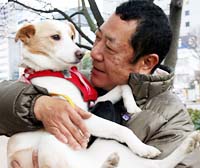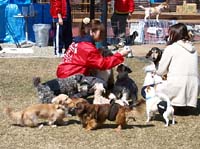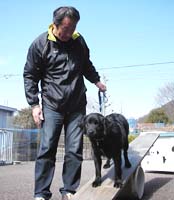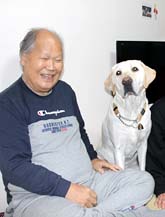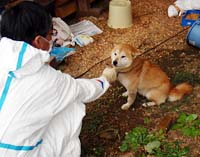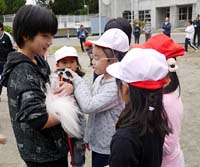Animals also earthquake victimsPeople and animals move forward together
Soon it will be one year since a massive earthquake shook eastern Japan. In addition to human beings, animals have also suffered from the impact of this disaster.
Pets are often thought of as members of the family. How are such pets, now separated from their families, surviving in the aftermath of the earthquake. And what should be done for guide dogs in the event of a natural disaster?
Let's consider what we can do to help these animals in order to further the reconstruction effort and create a peaceful society.
 |
Munehiro Takahashi of Fukuyama City |
| Adopting a dog from its owners |
Munehiro Takahashi, 52, is a company employee in the city of Fukuyama, east of Hiroshima. He now cares for a dog that was rescued from a city in Miyagi Prefecture in eastern Japan. The dog's name is "Satsuki," which can be translated to mean the month of "May." Mr. Takahashi loves animals and he volunteered to help care for dogs affected by the earthquake. He traveled to the city of Sendai in the wake of the disaster and assisted at a pet shop taking in dogs and cats. It was there that he came across Satsuki. Satsuki was found wandering through town after the city was deluged by the tsunami. At first, Mr. Takahashi intended to care for Satsuki until the dog's owners could be found. But when the owners turned out to be a man living in temporary housing, and his wife who was in the hospital, it became apparent that they wouldn't be able to keep their pet. So, last fall, Mr. Takahashi offered to be Satsuki's new owner. "Satsuki's former owners have entrusted me with their pet's life," Mr. Takahashi said. "I plan to keep the earthquake in my thoughts and remember my responsibility in caring for this creature." (Megumi Iwata, 17, Rena Sasaki, 15, and Yuka Ichimura, 15) | ||||
The pet shop in Sendai that provided shelter to Satsuki and other animals affected by the earthquake is called "Dog Wood." To date, this pet shop has voluntarily taken in 310 dogs and 130 cats, including pets whose owners were unable to bring them to evacuation centers. About 40% of these animals have been reunited with their owners. The other dogs and cats have been cared for at the pet shop or at the homes of volunteers and some of these animals have been adopted by new owners. Takashi Wagatsuma, 41, who works for "Dog Wood," made an appeal for volunteers, saying, "We would be happy to have junior high and high school students help walk the dogs. The amount of time you can spare doesn't matter. Please come join us." (Naho Shigeta, 13) |
 |
Tsuneo Yamaguchi of the Japan Animal Care Center |
| Training a dog from Fukushima to be a disaster rescue dog |
Tsuneo Yamaguchi, 60, the head of the Japan Animal Care Center, an NPO in the city of Gifu, has provided a home for a dog born in the town of Iidate in Fukushima Prefecture. Because of the accident at the nuclear power plant in that area, the whole town was forced to evacuate. Mr. Yamaguchi is now training the animal to serve as a disaster rescue dog. He hopes the dog will grow to rescue many victims of disaster in return for being saved from the earthquake zone. Mr. Yamaguchi took in the dog as a puppy last July. In the chaos following the nuclear accident, no owner could be found for it. He named the puppy "Jagaimo" ("Potato"). Jagaimo is now eight months old. He is an active dog and enjoys being around people. He is being trained to bark when he locates a person who needs help and has shown first-rate ability at this task. This fall Jagaimo will be tested to become an official disaster rescue dog. (Nene Takahashi, 16) |
 |
Muneo Harada of Fukushima Prefecture |
| Guide dogs are different from pets |
Muneo Harada, 67, of Iwaki, Fukushima Prefecture, uses a guide dog named Hearts. Thanks to Hearts, Mr. Harada narrowly escaped the tsunami, which followed the earthquake. He had a difficult time living at an evacuation center with Hearts and then finding a new place for them to live. "Guide dogs aren't pets," he told us. "They shouldn't be touched so freely." Mr. Harada was at home when the earthquake struck. He fled by car with his wife and Hearts, but the tsunami overpowered their vehicle and water began streaming inside. Just when he nearly lost hope, a young man happened to pass by. He noticed the white body of Hearts moving in the car and he waded through waist-high water to help them. At the evacuation center he was troubled by people petting Hearts. He explained that, when Hearts is petted, he becomes confused and thinks it's time to play. When Mr. Harada went searching for a new place to live and mentioned his guide dog, real estate agents would rebuff his efforts because they believed Hearts would be noisy. He now lives in prefectural housing, which permits residents to have guide dogs. (Junichi Akiyama, 16) |
 |
Fukushima Prefecture provides shelter to dogs and cats |
Fukushima Prefecture is providing shelter to dogs and cats that were living within 20 kilometers of the Fukushima No. 1 nuclear power plant when the earthquake hit. Because the area has been heavily affected by the nuclear accident, no one can say when these animals may be able to return to their former homes. The prefecture is housing 193 dogs and 54 cats (as of February 6) at two shelters. More than half of these animals are being kept there temporarily because the owners are unable to bring pets to a temporary housing facility or for other reasons. The owners of the remaining pets are not known, so new owners are being sought in order to avoid euthanizing the animals. Donations aid the prefectural government and the prefectural Veterinary Medical Association in maintaining the facilities. In the wake of the accident at the nuclear plant, many local residents were unable to evacuate with their pets. Staff of the prefectural government then helped the owners by bringing these animals, left behind in the evacuation area, to the shelters. One veterinarian, Tsuyoshi Ono, 44, said he felt sad when he saw a cat dying next to its owners' clothes, but he also remarked, "I'm glad when I can safely return a pet to its owner." (Sayaka Azechi, 17) |
 |
Dogs from Okinawa stir smiles among sufferers |
The Okinawa Disaster Rescue Dog Association, an NPO in the city of Uruma in Okinawa Prefecture, has sent "therapy dogs" certified by the association to the earthquake-affected areas. The aim is to ease the minds of sufferers through interactions with these animals. Last March, in the wake of the earthquake, the group dispatched rescue dogs to the scene, but they were forced to call off the effort due to heavy snow and a lack of fuel. Seeking to help in a different way, last fall they began providing "therapy dogs" to aid the healing process. Thus far the dogs have been taken two times to Iwate Prefecture and Fukushima Prefecture. Evacuees in temporary housing have a tendency to shut themselves off, but they enjoyed playing with the dogs and smiles were seen on the faces of elementary school children. A girl in sixth grade whose family was lost to the tsunami said her dream was to have her own big dog one day. Kaoru Koki, 60, the director of the association, said he hopes that playing with the dogs helps ease people's pain and enables them to feel positive again about the future. (Yumi Kimura, 15) |
